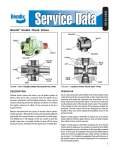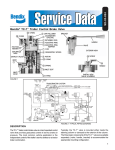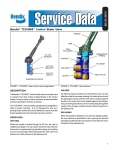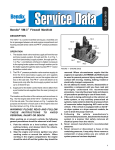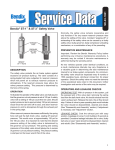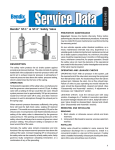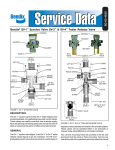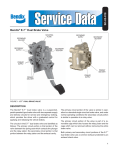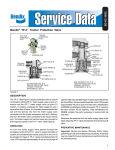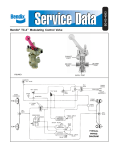Download BENDIX BW1567 User's Manual
Transcript
SD-03-821 ® Bendix® TC-6™ Trailer Control Brake Valve 8 14 10 KNOB 11 13 9 7 6 12 5 15 EXHAUST FIGURE 2 FIGURE 1 DESCRIPTION ® ™ The Bendix TC-6 trailer control brake valve is normally used to operate the trailer brakes independently of the tractor brakes. It may be used, however, wherever a hand controlled pressure graduation function is desired. The TC-6™ valve is handle operated and is designed for panel or dog house mounting. The TC-6™ trailer control brake valve is not designed for use as a parking brake control and should never be used to hold the brakes applied when the operator leaves the vehicle. OPERATION APPLYING When the handle (item 10) is pulled through its 75° arc, the roller cam (item 11) is rotated accordingly. The cam action forces the cam follower (item 9) downward, compressing the graduating spring (item 6) and creating a force on the plunger (item 12) which depresses the inlet valve (item 2) and delivers air under pressure to the delivery port. 4 2 3 DELIVERY 1 16 SUPPLY HOLDING As delivery pressure builds up in the delivery port, it is also effective under the plunger (12) causing it to balance the force of the graduating spring (6) until the inlet valve (2) is seated against its seat in the body and is also seated against the plunger (12), thus preventing the delivery air from exhausting through the center of the plunger (12), maintaining the desired pressure in the delivery line. RELEASING When the handle is released or moved to its release position, the cam follower (9) is permitted to rise, opening the exhaust passage and allowing the air pressure in the delivery line to exhaust out the exhaust port. PREVENTIVE MAINTENANCE Important: Review the Bendix Warranty Policy before performing any intrusive maintenance procedures. A warranty may be voided if intrusive maintenance is performed during the warranty period. 1 No two vehicles operate under identical conditions, as a result, maintenance intervals may vary. Experience is a valuable guide in determining the best maintenance interval for air brake system components. At a minimum, the TC-6™ valve should be inspected every 6 months or 1500 operating hours, whichever comes first, for proper operation. Should the TC-6™ valve not meet the elements of the operational tests noted in this document, further investigation and service of the valve may be required. If the valve does not function as described, or if the leakage is excessive, it is recommended that it be returned to the nearest Bendix authorized distributor for a factory remanufactured valve under the exchange plan. If this is not possible, the valve can be repaired with genuine Bendix parts, in which case the following should be helpful. The maintenance kit for the TC-6™ valve is part number 289890. Every 900 hours, 25,000 miles or every 3 months, drop some lubricant such as BW-650M silicone lubricant (Bendix part number 291126) (Dow Corning 55-M) through the handle operating slot, to re-lubricate the cam roller and hinge pin. Perform operating and leakage tests. Remove the valve from the panel. Place the lever in a vise and with a firm pull the rubber handle may be removed. Remove the two slotted head cap screws (14) which hold the mounting bracket in place as shown in Fig. 2 and remove the mounting bracket. REMOVING AND INSTALLING Secure vehicle with spring brakes or blocks. Drain the reservoir which supplies the TC-6™ valve. Remove the fasteners which secure the mounting bracket to the panel. Disconnect the connecting air lines. Remove valve. INSTALLING A typical piping arrangement for the TC-6™ valve is shown in Fig. 3. Check connecting air lines for integrity and foreign material. Replace lines if necessary. Re-connect air lines. Replace fasteners securing bracket to panel. Check operation of valve by charging system and performing the service check as described in this manual. SERVICE CHECKS OPERATING Connect an accurate test gauge to the trailer service line hose and leave the trailer emergency or supply hose connected to the trailer or if a trailer is not available, connect the trailer supply hose to an unvented dummy coupling or to a plugged hose fitting. The trailer supply valve should be in the normal position. When the operating lever is moved to the fully applied position, the gauge should register full reservoir pressure. Intermediate positions should deliver proportional intermediate pressures. Upon release, the gauge should immediately register zero. The location of the atmospheric end of the exhaust line from the valve should be found, probably in the engine compartment. With the TC-6™ valve in the release position, no pressure should register on the test gauge and leakage at the end of the exhaust line should not be greater than 100 SCCM (1" bubble in 5 seconds). With the valve fully applied, leakage at the exhaust line should not be greater than 175 SCCM (1" bubble in 3 seconds). 2 DISASSEMBLY Drive the pivot pin (13) out of the body with a drift punch. The handle (10), roller cam (11) and torsion spring (8) may now be removed. Remove the roller cam from the handle. The cam follower (9), graduating spring (6), plunger (12), and plunger return spring (4) may now be removed through the top of the valve. Care should be taken not to lose washer (15). Place the body in a soft-jawed vise and remove cap nut (16). Remove o-ring (1) from cap nut. Inlet valve spring (3) and inlet valve (2) may now be removed. CLEANING AND INSPECTION OF PARTS Clean all metal and plastic parts with mineral spirits or equivalent. Wipe all o-rings and rubber parts dry. Replace any which show signs of wear or deterioration. Inspect valve seats for nicks or burrs and remove any deposits. Check all springs for distortion, cracks and corrosion. Replace all parts not considered serviceable after inspection. ASSEMBLY Before assembling the valve all bores, cam, pivot pin, plungers, and o-rings should be lubricated with silicone lubricant Dow Corning 55-M (Bendix part number 291126). Place body in a soft-jawed vise with ports pointing up. Place inlet valve (2) in inlet cavity and install inlet valve spring (3). Place o-ring (1) on cap nut (16) and assemble cap nut in body. Torque cap nut to 50-150 inch pounds. Install o-rings (5) and (7) on plunger (12) and cam follower (9). Caution: o-ring (7) is slightly larger than (5) and goes on the cam follower (9). Reverse position of body in vise and install plunger return spring (4), plunger (12), washer (15), graduating spring (6), and cam follower (9). Note: The cam follower must be positioned so that the projection on the side of the body matches the corresponding groove in the body. DOUBLE CHECK VALVE SERVICE LINE TP-3™ VALVE TC-6™ VALVE TO REAR BRAKES DOUBLE CHECK VALVE TO FRONT BRAKES REAR BRAKE RESERVOIR SUPPLY RESERVOIR FRONT BRAKE RESERVOIR FIGURE 3 Position the torsion spring (8) in its approximate position in the body so that the end which engages the handle rests against the side of the body opposite the bracket retaining screw holes. Place the roller cam (11) in position as shown in Fig. 2 and insert pivot pin (13) through the torsion spring and partially through the roller cam, leaving room to insert the wedge shaped end of the handle. With a small screwdriver or similar tool, force the tang of the torsion spring towards the opposite wall of the body far enough so the handle (10) may be inserted into the roller cam. The pivot pin (13) may then be tapped on through until the ends of the pin are flush with either side of the body. Place the mounting bracket in position and secure with two slotted head cap screws (14). Place the rubber knob back on the handle. Reinstall the valve on the vehicle and test per “operating leakage checks” in this manual. WARNING! PLEASE READ AND FOLLOW THESE INSTRUCTIONS TO AVOID PERSONAL INJURY OR DEATH: When working on or around a vehicle, the following general precautions should be observed at all times. 1. Park the vehicle on a level surface, apply the parking brakes, and always block the wheels. Always wear safety glasses. 2. Stop the engine and remove ignition key when working under or around the vehicle. When working in the engine compartment, the engine should be shut off and the ignition key should be removed. Where circumstances require that the engine be in operation, EXTREME CAUTION should be used to prevent personal injury resulting from contact with moving, rotating, leaking, heated or electrically charged components. 3. Do not attempt to install, remove, disassemble or assemble a component until you have read and thoroughly understand the recommended procedures. Use only the proper tools and observe all precautions pertaining to use of those tools. 3 4. If the work is being performed on the vehicle’s air brake system, or any auxiliary pressurized air systems, make certain to drain the air pressure from all reservoirs before beginning ANY work on the vehicle. If the vehicle is equipped with an AD-IS™ air dryer system or a dryer reservoir module, be sure to drain the purge reservoir. 5. Following the vehicle manufacturer’s recommended procedures, deactivate the electrical system in a manner that safely removes all electrical power from the vehicle. 6. Never exceed manufacturer’s recommended pressures. 7. Never connect or disconnect a hose or line containing pressure; it may whip. Never remove a component or plug unless you are certain all system pressure has been depleted. 4 8. Use only genuine Bendix ® replacement parts, components and kits. Replacement hardware, tubing, hose, fittings, etc. must be of equivalent size, type and strength as original equipment and be designed specifically for such applications and systems. 9. Components with stripped threads or damaged parts should be replaced rather than repaired. Do not attempt repairs requiring machining or welding unless specifically stated and approved by the vehicle and component manufacturer. 10. Prior to returning the vehicle to service, make certain all components and systems are restored to their proper operating condition. BW1567 © 2004 Bendix Commercial Vehicle Systems LLC. All rights reserved. 3/2004 Printed in U.S.A.




